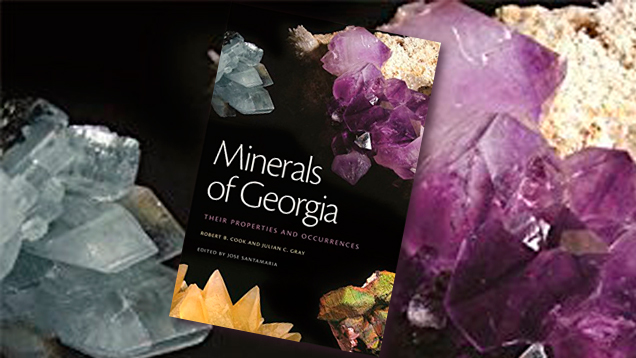Book Review: Minerals of Georgia: Their Properties and Occurrences

This book is an updated version of Dr. Cook’s original volume, published in 1978. It has a revised format as minerals are listed alphabetically rather than by chemical class, with allowances given to mineral groups such as garnet and tourmaline.
The description of the geology is not overly technical but still gives the big picture. The distinction is made between crystalline and sedimentary regions. The state has five distinct geologic provinces. The Piedmont and Blue Ridge provinces of northern Georgia are underlain almost exclusively by metamorphic and igneous rocks. The Coastal Plain, which covers the southern half of the state, mostly consists of unconsolidated sediments and some limestones. In the northwest corner of the state, the Cumberland Plateau contains relatively undeformed Paleozoic sediments while the Ridge and Valley regions consist of folded sedimentary rocks.
In-depth sections focus on the state’s remarkable finds of rutile and amethyst. Georgia’s amethyst is considered the nation’s finest. The Charlies Creek material is quite distinctive, as it occurs in short single crystals or groups of only two or three distinctly color-zoned crystals. In either instance, amethyst is found in the rhombohedral zones of the pyramidal terminations. The prismatic sections are often colorless. Jacksons Crossroads in Wilkes County has produced the finest amethyst in the United States. Spectacular specimens have found their way into important private collections, while faceted material with deep purple color is entering the gem market. Benny Ray specimens are quite different from those found at Charlies Creek or Jacksons Crossroads, occurring in irregular narrow pockets in massive milky vein quartz.
Graves Mountain is famous for its rutile specimens and fine lazulite. The rutile crystals are unsurpassed in terms of crystal perfection, twinning, size, and luster. Fifty–one mineral species are reported from this locale.
The highlight of the book is the chapter with alphabetical descriptions of Georgia’s mineral species. Every mineral is fully documented: chemical formula, classification, crystallographic information, habit, physical properties, and occurrences listed alphabetically by county.
The volume is successful in presenting the most accurate, up-to-date information available on the subject. It is the ultimate bible of Georgia’s mineralogy. The work is well written and illustrated, with more than 150 color photographs. It is suited for collectors, mineralogists, and treasure hunters. It contains handy appendix sections, complete with a County Index, a Locality Index with mineral occurrences, and a Mineral Index. I highly recommend it.



